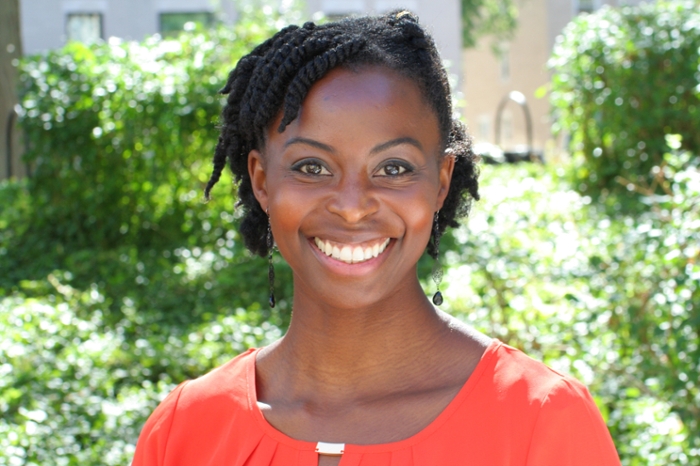Faculty Spotlight: Onnie Rogers
IPR developmental psychologist examines how children form their identities
Get all our news
In some ways, it suggests that white kids and kids of color are navigating very different racial worlds and they're thinking about the racialized self in very different terms.”
Onnie Rogers
Assistant professor of psychology and an IPR fellow

IPR developmental psychologist Onnie Rogers examines how stereotypes affect youth identity.
As an undergraduate student at the University of California, Los Angeles, and as the only African-American gymnast on her college team, IPR developmental psychologist Onnie Rogers often found herself feeling like an “exception.”
“I remember reading studies in my undergraduate courses and thinking ‘I’m not supposed to be here,’” Rogers said. “My parents didn’t go to college, we’re an African-American family, working class …. All of the data said I really shouldn’t be in college.”
Rogers said she was troubled by this idea of being “special” somehow for making it, sparking questions about identity and self-perception. These questions have informed her research, which focuses on how cultural norms, expectations, and stereotypes affect how youth see themselves, particularly in terms of schooling and education.
Identity Development
The idea of self is central across the world and across the lifespan, with some even arguing that the “quest of life” is searching to figure out who we are, according to Rogers. But “we don’t live inside a little box and just decide independently who we’re going to be,” she pointed out. “Our identities are inherently shaped by the contexts in which we’re embedded, the historical moment, and societal beliefs, expectations, and stereotypes.”
So what do children understand about their identities? Rogers, along with Andrew Meltzoff of the University of Washington, interviewed 222 African-American, white, and mixed-race children at three racially diverse schools in Tacoma, Washington. The researchers asked the children to rate how important racial and gender identities were to them—either “not much,” “a little bit,” or “a lot.”
In the 2016 study published in Cultural Diversity and Ethnic Minority Psychology, children overall rated gender as a more important identity than race, but African-American and mixed-race children ranked race as more important than white children. Moreover, children who rated race as not important were more likely to define race by saying “everybody is the same.” But children who said race was important to them defined racial identity as a sense of pride and an awareness of group differences.
"In some ways, it suggests that white kids and kids of color are navigating very different racial worlds and they're thinking about the racialized self in very different terms," Rogers said.
"The issue is not that we're different. It's in the hierarchy and the value that's placed on those differences," Rogers explained. "We really need more data and understanding of which messages promote social justice and equity, and which promote blindness, avoidance, and silence."
Resisting Stereotypes
Stereotypes influence how children form their identities, but that doesn’t mean children automatically accept society’s expectations for them.
“We all live in a system of oppression, but we’re not passive recipients of that oppression,” Rogers explained. “We’re active agents, and one of the ways we respond is by challenging or resisting those systems of oppression as we form our identities.”
Rogers examined how African-American adolescent boys resist stereotypes in a 2016 study with New York University’s Niobe Way published in the Journal of Adolescent Research. Rogers and Way drew data from interviews with 21 adolescent African-American boys, finding they resist racial stereotypes more readily than gender stereotypes.
Based on the boys’ responses, the researchers determined they fit into three groups: accommodators, who endorsed racial and gender stereotypes; resisters, who challenged both types of stereotypes; and exceptions, who resisted racial stereotypes but accommodated to ones about gender.
Most of the boys were able to name and reject negative racial stereotypes. For example, one boy said, “Society says that we are illiterate and that’s not true.” However, two-thirds of the boys said there were no stereotypes about boys or that these gender stereotypes were “natural.”
Rogers is extending this line of research to examine if younger children also exhibit resistance to stereotypes, and how resistance changes between second grade and sixth grade.
Shaping Conversations About Race
“Youth are getting messages about who and what they can and can’t be” through the curriculum they’re assigned, the books they read, the clubs offered at school, the media, parents, and peers, according to Rogers. She said one way to address the content of these messages is by building capacity to engage youth in conversations about race and gender.
Toward this goal, Rogers, through the Institute for Learning and Brain Sciences at the University of Washington, has created two online learning modules as educational tools for teachers, parents, and community members.
These modules address what kids know about race, and how societal ideas about race can affect children’s ideas about the self. They also give advice on how to talk to kids about race.
“Teachers can be agents of change,” Rogers said. “If we are more aware of the way stereotypes restrict identity and restrict how children see themselves, we can be explicit about changing that narrative.”
Onnie Rogers is assistant professor of psychology and an IPR fellow.
Photo credit: J. Ziv
Published: November 21, 2016.